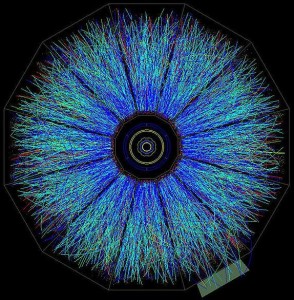WEDNESDAY, 4 MAY 2011
As expected at the birth of the universe, when the Big Bang created equal amounts of matter and antimatter, collisions between gold nuclei inside the STAR experiment (Solenoidal Tracker at RHIC) in New York created roughly equal amounts of matter and antimatter. The heavy-ion collisions recreate the conditions of the hot, dense early universe, and produce fireballs that rapidly expand and cool. Antimatter produced in the collision can avoid annihilation long enough to be detected in the Time Projection Chamber [1].A number of different antimatter species are produced by heavy-ion collisions; the most common are the least massive because it takes the least energy to create them. As a result, the antielectron was the first antiparticle to be detected, in cosmic ray debris in the 1950s, followed by antiprotons and antineutrons. Only now have antihelium particles, having baryon number 4 (two antiprotons and two antineutrons), been found.
The next stable antimatter nucleus would be antilithium, whose production rate in a particle accelerator is expected to be over two million times less than antihelium. A breakthrough in accelerator technology will be needed to detect it [2].
Written by Robert Jones

